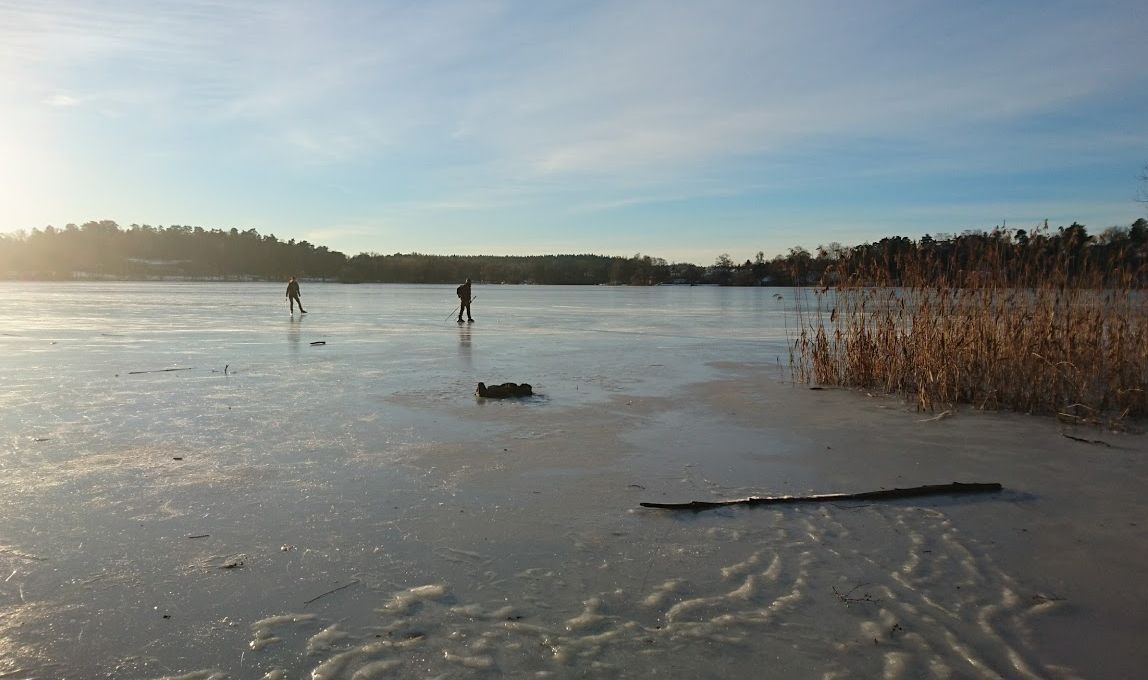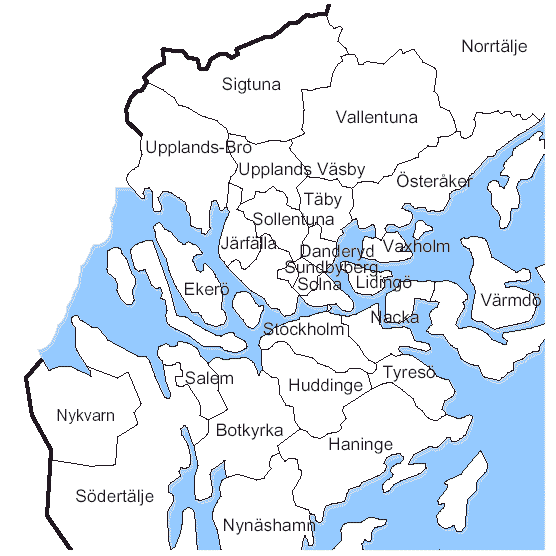|
Uppland Runic Inscription 100
Uppland Runic Inscription 100 is the Rundata designation for a memorial runestone that is located in the forest where a path meets a bog near Skälby, which is about two kilometers northeast of Sollentuna, Stockholm County, Sweden, which was part of the historical province of Uppland. Description This runestone, which is made of granite and is 2.1 meters in height, has an inscription which consists of runic text within serpent bands and a Christian cross. It is classified as being carved in runestone style Pr4,Project Samnordisk Runtextdatabas Svensk - Rundata entry for U 100. which is part of the general |
Uppland
Uppland () is a historical province or ' on the eastern coast of Sweden, just north of Stockholm, the capital. It borders Södermanland, Västmanland and Gästrikland. It is also bounded by lake Mälaren and the Baltic Sea. On the small uninhabited island of Märket in the Baltic, Uppland has a very short and unusually shaped land border with Åland, an autonomous province of Finland. The name literally means ''up land'', a name which is commonly encountered in especially older English literature as ''Upland''. Its Latinised form, which is occasionally used, is ''Uplandia''. Uppland is famous for having the highest concentration of runestones in the world, with as many as 1,196 inscriptions in stone left by the Vikings. Administration The traditional provinces of Sweden serve no administrative or political purposes, but are historical and cultural entities. The corresponding administrative county, or ', is Uppsala County, which occupies the larger part of the territory. The b ... [...More Info...] [...Related Items...] OR: [Wikipedia] [Google] [Baidu] |
Sweden
Sweden, formally the Kingdom of Sweden,The United Nations Group of Experts on Geographical Names states that the country's formal name is the Kingdom of SwedenUNGEGN World Geographical Names, Sweden./ref> is a Nordic country located on the Scandinavian Peninsula in Northern Europe. It borders Norway to the west and north, Finland to the east, and is connected to Denmark in the southwest by a bridgetunnel across the Öresund. At , Sweden is the largest Nordic country, the third-largest country in the European Union, and the fifth-largest country in Europe. The capital and largest city is Stockholm. Sweden has a total population of 10.5 million, and a low population density of , with around 87% of Swedes residing in urban areas in the central and southern half of the country. Sweden has a nature dominated by forests and a large amount of lakes, including some of the largest in Europe. Many long rivers run from the Scandes range through the landscape, primarily ... [...More Info...] [...Related Items...] OR: [Wikipedia] [Google] [Baidu] |
Old Norse Language
Old Norse, Old Nordic, or Old Scandinavian, is a stage of development of North Germanic languages, North Germanic dialects before their final divergence into separate Nordic languages. Old Norse was spoken by inhabitants of Scandinavia and their Viking expansion, overseas settlements and chronologically coincides with the Viking Age, the Christianization of Scandinavia and the consolidation of Scandinavian kingdoms from about the 7th to the 15th centuries. The Proto-Norse language developed into Old Norse by the 8th century, and Old Norse began to develop into the modern North Germanic languages in the mid-to-late 14th century, ending the language phase known as Old Norse. These dates, however, are not absolute, since written Old Norse is found well into the 15th century. Old Norse was divided into three dialects: Old West Norse, ''Old West Norse'' or ''Old West Nordic'' (often referred to as ''Old Norse''), Old East Norse, ''Old East Norse'' or ''Old East Nordic'', and ''Ol ... [...More Info...] [...Related Items...] OR: [Wikipedia] [Google] [Baidu] |
Rundata
The Scandinavian Runic-text Data Base ( sv, Samnordisk runtextdatabas) is a project involving the creation and maintenance of a database of runic inscriptions. The project's goal is to comprehensively catalog runestones in a machine-readable way for future research. The database is freely available via the Internet with a client program, called Rundata, for Microsoft Windows. For other operating systems, text files are provided or a web browser can be used to interact with the web applicatioRunor History The origin of the Rundata project was a 1986 database of Swedish inscriptions at Uppsala University for use in the Scandinavian Languages Department. At a seminar in 1990 it was proposed to expand the database to cover all Nordic runic inscriptions, but funding for the project was not available until a grant was received in 1992 from the ''Axel och Margaret Ax:son Johnsons'' foundation. The project officially started on January 1, 1993 at Uppsala University. After 1997, the proje ... [...More Info...] [...Related Items...] OR: [Wikipedia] [Google] [Baidu] |
Runestone
A runestone is typically a raised stone with a runic inscription, but the term can also be applied to inscriptions on boulders and on bedrock. The tradition began in the 4th century and lasted into the 12th century, but most of the runestones date from the late Viking Age. Most runestones are located in Scandinavia, but there are also scattered runestones in locations that were visited by Norsemen during the Viking Age. Runestones are often memorials to dead men. Runestones were usually brightly coloured when erected, though this is no longer evident as the colour has worn off. The vast majority of runestones are found in Sweden. History The tradition of raising stones that had runic inscriptions first appeared in the 4th and 5th century, in Norway and Sweden, and these early runestones were usually placed next to graves. The earliest Danish runestones appeared in the 8th and 9th centuries, and there are about 50 runestones from the Migration Period in Scandinavia. Most runeston ... [...More Info...] [...Related Items...] OR: [Wikipedia] [Google] [Baidu] |
Sollentuna Municipality
Sollentuna Municipality ( ) is a municipality in Stockholm County in east-central Sweden, north of Stockholm. Its seat of local government is located in Tureberg, which is a part of Sollentuna urban area. Geography Sollentuna borders the municipalities of Solna, Sundbyberg, Stockholm, Järfälla, Upplands Väsby, Täby and Danderyd in clockwise order starting to the south. Localities and districts Since 1995 the bulk of the built-up area of the municipality is statistically counted to the multimunicipal city of Stockholm. A few houses on the eastern border (with about 10 inh.) are in Täby urban area. Sjöberg is constituting a locality of its own. The municipality is subdivided into the following districts according to population as of 31 December 2021 https://www.sollentuna.se/kommun--politik/kommunfakta/befolkningen-i-sollentuna/ * Tureberg, 19 127 inhabitants *Rotebro, 8 824 * Helenelund, 12 678 * Edsberg, 12 338 * Viby, 5,748 * Sjöberg, 4,705 * Häggvik, 5 5 ... [...More Info...] [...Related Items...] OR: [Wikipedia] [Google] [Baidu] |
Stockholm County
Stockholm County ( sv, Stockholms län, link=no ) is a county or '' län'' (in Swedish) on the Baltic Sea coast of Sweden. It borders Uppsala County and Södermanland County. It also borders Mälaren and the Baltic Sea. The city of Stockholm is the capital of Sweden. Stockholm County is divided by the historic provinces of Uppland (Roslagen) and Södermanland (Södertörn). More than one fifth of the Swedish population lives in the county. Stockholm County is also one of the statistical '' riksområden'' (national areas) according to NUTS:SE, Nomenclature of Territorial Units for Statistics within the EU. With more than two million inhabitants, Stockholm is the most densely populated county of Sweden. History Stockholm County was established in 1714. The City of Stockholm then constituted its own administrative entity under the Governor of Stockholm and was not part of Stockholm County. Though outside Stockholm County, the City of Stockholm was its seat. On 1 January 196 ... [...More Info...] [...Related Items...] OR: [Wikipedia] [Google] [Baidu] |
Runestone Style
:''The term "runestone style" in the singular may refer to the Urnes style.'' The style or design of runestones varied during the Viking Age. The early runestones were simple in design, but towards the end of the runestone era they became increasingly complex and made by travelling runemasters such as Öpir and Visäte. A categorization of the styles was developed by Anne-Sophie Gräslund in the 1990s. Her systematization is considered to have been a break-through and is today a standard. The styles are RAK, Fp, Pr1, Pr2, Pr3, Pr4 and Pr5, and they cover the period 980-1130, which was the period during which most runestones were made. The styles Pr1 and Pr2 correspond to the Ringerike style, whereas Pr3, Pr4 and Pr5 belong to what is more widely known as the Urnes style.Sawyer 2000:32 Below follows a brief presentation of the various styles by showing sample runestones according to Rundata's annotation. RAK RAK is the oldest style and covers the period 980-1015 AD, but the Ru ... [...More Info...] [...Related Items...] OR: [Wikipedia] [Google] [Baidu] |
Urnes Style
Viking art, also known commonly as Norse art, is a term widely accepted for the art of Scandinavian Norsemen and Viking settlements further afield—particularly in the British Isles and Iceland—during the Viking Age of the 8th-11th centuries. Viking art has many design elements in common with Celtic, Germanic, the later Romanesque and Eastern European art, sharing many influences with each of these traditions. Generally speaking, the current knowledge of Viking art relies heavily upon more durable objects of metal and stone; wood, bone, ivory and textiles are more rarely preserved. The artistic record, therefore, as it has survived to the present day, remains significantly incomplete. Ongoing archaeological excavation and opportunistic finds, of course, may improve this situation in the future, as indeed they have in the recent past. Viking art is usually divided into a sequence of roughly chronological styles, although outside Scandinavia itself local influences are ofte ... [...More Info...] [...Related Items...] OR: [Wikipedia] [Google] [Baidu] |
Arkils Tingstad
Arkils tingstad ("Assembly location of Arkil") is the remains of the Viking Age thing or assembly location of a hundred in Uppland, Sweden. It is situated on the outskirts of Stockholm. The remains consist of a rectangular stone formation and two runestones. The runestones and the assembly location were created by the Skålhamra clan who also had the two Risbyle Runestones made across the lake near their estate. It consequently appears that they owned land on both sides of the lake.A presentation on the website of the They also made the [...More Info...] [...Related Items...] OR: [Wikipedia] [Google] [Baidu] |
Risbyle Runestones
The Risbyle Runestones are two runestones found near the western shore of Lake Vallentunasjön in Uppland, Sweden, dating from the Viking Age. Description The Risbyle Runestones, listed in the Rundata catalog as U 160 and U 161, were engraved in Old Norse with the Younger Futhark in the early 11th century by the Viking Ulf of Borresta (''Báristaðir'') who had partaken three times in the danegeld in England and raised the runestone U 336 in the same region. They were raised in memory of Ulf of Borresta's kinsman-by-marriage Ulf in Skolhamarr (Skålhammar). One of the runestones, U 161, has the Eastern cross which shows the influence of Byzantine culture on Sweden at this time through the Varangians who returned after having served the Emperor in Constantinople (see also the Greece Runestones and the Italy Runestones). The cross is today the coat-of-arms of Täby Municipality. Both runestones are in the style Pr1, [...More Info...] [...Related Items...] OR: [Wikipedia] [Google] [Baidu] |




